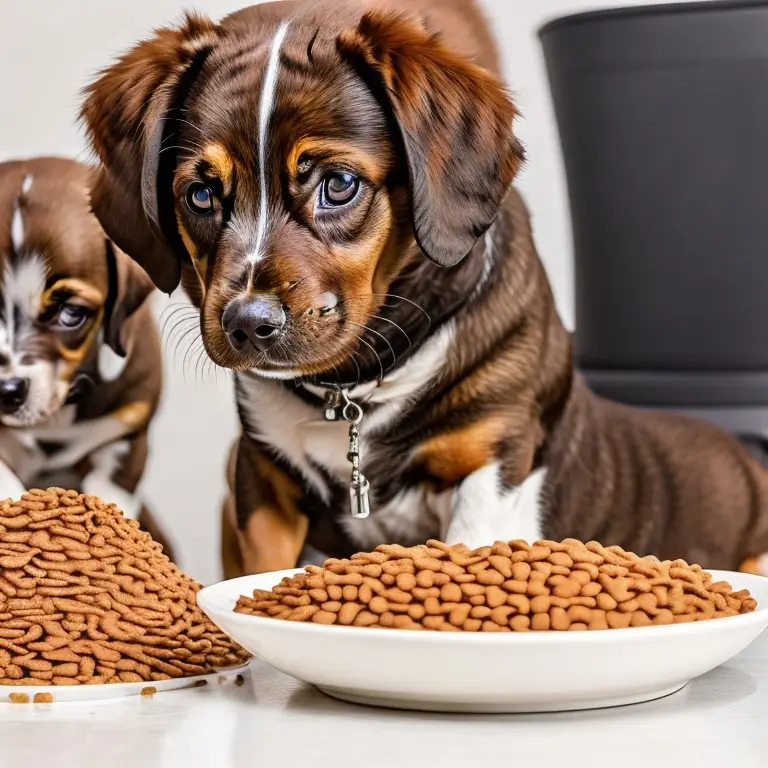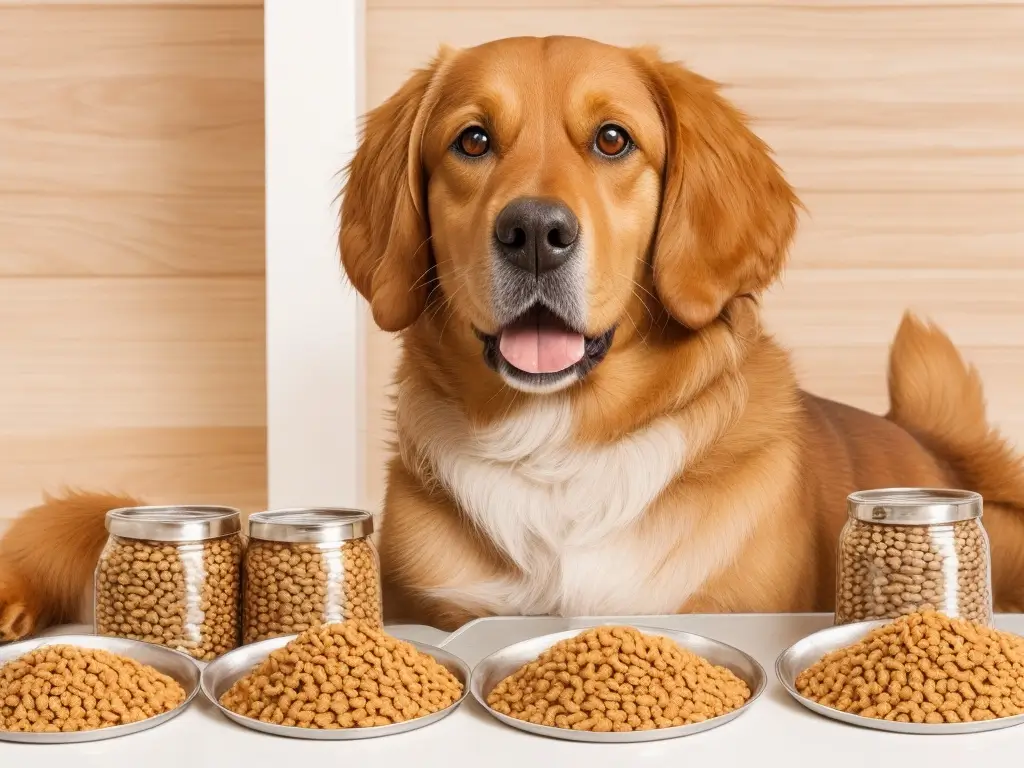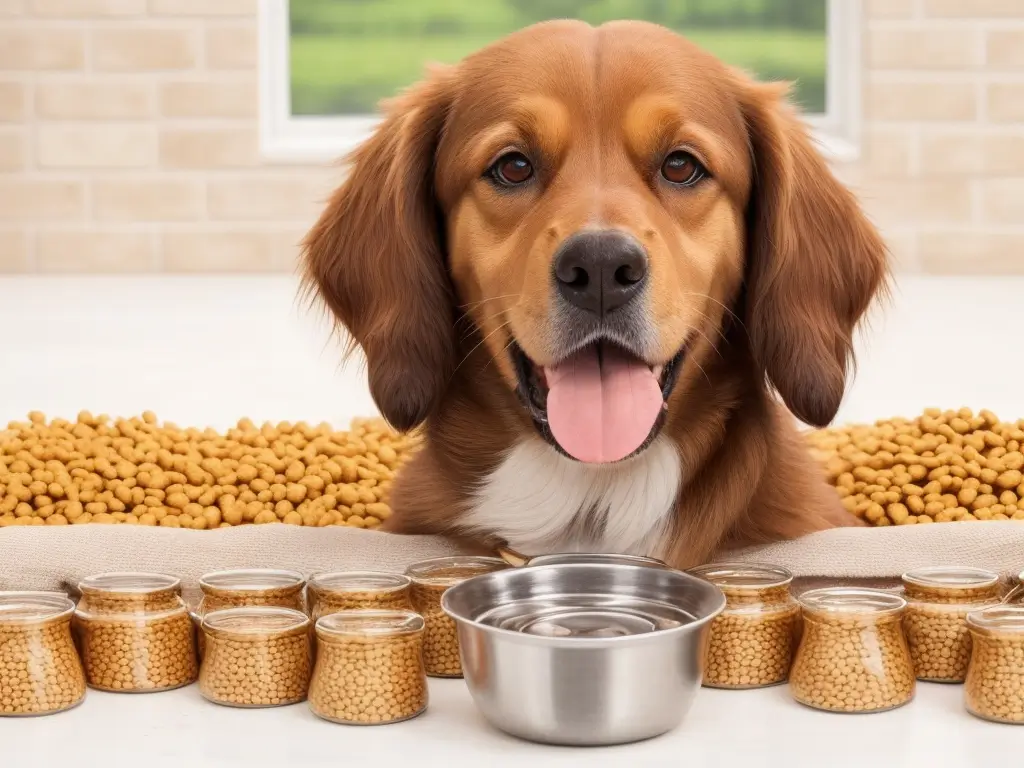When pondering the question, “how many cups of dog food in a pound?”, it quickly becomes evident that this is not just a matter of simple conversion. It’s a crucial query that pet owners, particularly dog owners, often find themselves contemplating. Accurate measurement is paramount when it comes to feeding our furry companions, as it directly impacts their health and well-being.
In this article, we will delve deep into the significance of measuring dog food accurately, explore the various factors that can influence these measurements, and provide practical insights to help dog owners make informed decisions. Whether you are a new dog parent or have been one for years, understanding the correct amount to feed your pet is essential to ensure they are getting the right nutrition in the right proportions.

Measuring dog food accurately is not just about maintaining a healthy weight; it’s about fostering optimal health, preventing nutritional deficiencies or excesses, and promoting a long, happy, and active life for our dogs. So, let’s embark on this journey to uncover the intricacies behind measuring dog food and to answer the pivotal question: how many cups are in a pound of dog food?
Importance of Accurate Measurement
Understanding how many cups of dog food in a pound is more than a mere mathematical conversion; it’s a cornerstone for maintaining the optimal health of our canine companions. Accurate measurement plays a pivotal role in preventing the consequences of both overfeeding and underfeeding, which can lead to a myriad of health issues and diminish the quality of life for our pets.
Consequences of Inaccurate Measurement
- Overfeeding: Leads to obesity, which is a gateway to numerous health problems such as diabetes, heart disease, and joint issues. It can also result in a reduced lifespan and diminished quality of life.
- Underfeeding: Results in malnutrition and its associated health problems, including weakened immune system, poor coat and skin condition, and developmental issues in puppies.

The Role of Accurate Measurement in Optimal Health
Accurate measurement ensures that our dogs receive the right amount of food, balanced with the necessary nutrients, to support their overall well-being. It aids in:
- Maintaining Healthy Weight: Proper portion control is crucial to prevent obesity and keep our dogs in their ideal weight range.
- Balanced Nutrition: Ensures that dogs receive the right amount of proteins, fats, carbohydrates, vitamins, and minerals needed for their age, breed, and health status.
- Preventing Health Issues: Helps in avoiding health problems related to improper nutrition and dietary imbalances.
Practical Implications
Knowing how many cups in a pound of dog food enables pet owners to feed their dogs the right quantity of food, tailored to their specific needs, lifestyle, and preferences. It empowers owners to make informed decisions and contribute positively to their pets’ longevity and happiness.
In conclusion, the pursuit of understanding how many cups of dog food is in a pound is not trivial; it’s a vital aspect of responsible pet ownership, ensuring our dogs lead healthy, balanced, and joyful lives.

Factors Influencing Measurement
When considering how many cups of dog food in a pound, it’s crucial to acknowledge the various factors that can influence this measurement. The conversion is not uniform and can vary significantly based on several elements related to the dog food’s composition and form.
Kibble Size and Density
- Kibble Size: Larger kibble pieces will occupy more space in a cup, resulting in fewer pieces per cup and potentially less weight per cup.
- Density: Denser kibbles will weigh more per cup compared to lighter, airier kibbles.
Type of Dog Food
- Dry Dog Food: Typically measured by volume (cups) or weight (pounds), and the conversion can vary based on density and kibble size.
- Wet Dog Food: Usually sold by weight, and its measurement in cups can be tricky due to its moisture content.
Dry vs Wet Dog Food
Understanding the difference between measuring dry and wet dog food is vital. Wet dog food is generally denser and contains more water, affecting the weight-to-volume ratio, making it essential to adjust measurements accordingly to avoid overfeeding or underfeeding.
Standard Measurement Conversion
Delving deeper into how many cups in a lb of dog food, it’s imperative to understand the standard conversion between cups and pounds and be aware of the variations that can occur due to the different types and compositions of dog food.
Standard Conversion
Typically, the standard conversion is based on the assumption that one cup of dog food weighs approximately 8 ounces (0.5 pounds). However, this can vary, and it’s essential to refer to feeding guidelines provided by the dog food manufacturer.

Variations in Conversion
Different types of dog food will have different conversions due to variations in ingredients, density, and kibble size. For instance, grain-free foods may have different cup to pound ratios compared to grain-inclusive foods.
Table of Conversion Variations
| Type of Dog Food | Approximate Cups per Pound |
|---|---|
| Standard Kibble | 2 cups |
| Dense Kibble | 1.5 cups |
| Light/Airy Kibble | 2.5 cups |
| Wet Dog Food | Varies |
Conclusion
Understanding the standard measurement conversion and the factors influencing the measurement is crucial when determining how many cups of dog food are in a pound. Being aware of the variations and adjusting measurements accordingly ensures that our pets receive the right amount of food and nutrition they need.
Brand Variations
In the quest to determine how many cups of dog food in a pound, it is crucial to consider the variations that exist among different brands. Each brand formulates its dog food differently, leading to variations in ingredients, density, and, consequently, the cup to pound ratio.
Ingredient and Density Variations
Different brands use diverse ingredients, which can significantly affect the density of the dog food. For example, a brand using more protein-rich ingredients may have denser kibble compared to a brand using more carbohydrate-rich ingredients.
Grain-Free vs Grain-Inclusive Dog Foods
- Grain-Free Dog Foods: Typically denser and may have a different cup to pound ratio compared to grain-inclusive foods.
- Grain-Inclusive Dog Foods: May be lighter and occupy more volume per pound, affecting the number of cups in a pound.
Conclusion on Brand Variations
Being aware of the brand-specific variations is essential for accurate measurement and ensuring our pets receive the correct amount of food. It is always recommended to refer to the feeding guidelines provided by the dog food manufacturer to determine the accurate cup to pound ratio for that specific brand.
Tools and Techniques for Measurement
To accurately determine how many cups in a pound of dog food, utilizing the right tools and techniques is indispensable. Accurate measurement is the key to feeding the right amount of food to our pets, preventing overfeeding or underfeeding.
Measuring Tools
- Measuring Cups: A standard kitchen measuring cup can be used to measure the volume of dog food.
- Scales: A kitchen scale can provide a more accurate measurement by weight, especially useful for determining the amount of wet dog food.
Online Tools and Apps
Several online tools and apps can assist pet owners in converting measurements and determining the right amount of food to feed their pets based on various factors like age, weight, activity level, and health status.
Conclusion on Tools and Techniques
Employing the right tools and techniques is crucial in accurately determining how many cups are in a pound of dog food. Whether using measuring cups, scales, or online tools, ensuring precision in measurement is fundamental in maintaining the health and well-being of our furry friends.
Practical Examples
To truly grasp how many cups of dog food in a pound, let’s delve into some practical, real-life examples and scenarios. These examples will illustrate the conversion between cups and pounds for various dog food brands and types, providing a clearer understanding of how different factors can affect the measurement.
Example Scenarios
- Brand A (Standard Kibble): For a standard kibble with average density, you might find that one pound of dog food equals approximately two cups.
- Brand B (Dense, Grain-Free Kibble): A denser, grain-free kibble might have a different ratio, with one pound equating to roughly one and a half cups.
- Brand C (Light, Airy Kibble): In contrast, a lighter, airy kibble might offer more volume, with one pound being equivalent to about two and a half cups.
Presentation of Data
To illustrate these variations more clearly, here’s a concise table representing the different conversions for the mentioned examples:
| Brand | Type of Kibble | Approximate Cups per Pound |
|---|---|---|
| A | Standard Kibble | 2 cups |
| B | Dense, Grain-Free Kibble | 1.5 cups |
| C | Light, Airy Kibble | 2.5 cups |
Special Considerations
When determining how many cups in a pound of dog food, it’s essential to consider the special needs and circumstances of individual dogs, such as puppies, senior dogs, active dogs, and sedentary dogs. These considerations are crucial as they can significantly impact the amount of food required.
Adjustments for Different Life Stages and Lifestyles
- Puppies: Require more protein and calories per pound of body weight to support their growth and development.
- Senior Dogs: May have slower metabolisms and, thus, lower caloric needs, often benefiting from diets formulated to support aging joints and organs.
- Active Dogs: Have higher energy expenditures and typically require more calories to maintain their weight and support their activity levels.
- Sedentary Dogs: May require fewer calories to prevent obesity and related health issues.
Importance of Individual Consideration
Taking into account the dog’s health, lifestyle, and preferences is paramount when measuring food. It ensures that the dog receives the right amount of nutrients and energy to maintain optimal health, vitality, and quality of life.
Conclusion
Understanding the practical examples and considering the special needs of individual dogs are crucial steps in accurately determining how many cups of dog food are in a pound. By paying attention to these aspects, dog owners can ensure their pets receive a balanced and appropriate diet tailored to their unique needs and circumstances.
Nutritional Considerations
When exploring how many cups of dog food in a pound, it is imperative to consider the nutritional content and caloric density of the food. These factors are pivotal in determining the appropriate amount of food to be fed, ensuring that our dogs receive the balanced nutrition they require for optimal health and vitality.
Role of Nutritional Content and Caloric Density
- Nutritional Content: The proportions of proteins, fats, carbohydrates, vitamins, and minerals in dog food are crucial in maintaining a dog’s health and must be balanced according to the dog’s specific needs.
- Caloric Density: Foods with higher caloric density provide more energy per cup, affecting the amount needed to meet the dog’s caloric requirements.
Adjusting Portions for Individual Needs
It’s essential to adjust portions based on each dog’s nutritional needs, health status, age, activity level, and preferences. This ensures that the dog receives the right amount of nutrients and maintains a healthy weight, preventing nutritional deficiencies or excesses.
Conclusion on Nutritional Considerations
Understanding the nutritional considerations is crucial when determining how many cups in a pound of dog food. By paying attention to the nutritional content and caloric density of the food, and adjusting portions accordingly, we can promote the well-being and longevity of our furry friends.
Conclusion
In conclusion, determining how many cups of dog food in a pound is a multifaceted consideration, involving various factors such as brand variations, kibble size, density, type of dog food, and the individual needs of the dog. Accurate measurement is paramount in providing our pets with the balanced nutrition they require to thrive.
Key Points Summary
- Accurate measurement is crucial to prevent overfeeding or underfeeding, which can lead to various health issues.
- Different brands and types of dog food have different cup to pound ratios due to variations in ingredients and density.
- Special considerations are needed for puppies, senior dogs, active dogs, and sedentary dogs to meet their unique nutritional requirements.
- Nutritional content and caloric density play a significant role in determining the appropriate amount of food to be fed.
Call-to-Action
Let’s embrace the responsibility of accurate measurement and mindful feeding to ensure the health and happiness of our canine companions. Always refer to the feeding guidelines provided by the dog food manufacturer and adjust portions based on your dog’s individual needs, lifestyle, and preferences. And remember, when in doubt, consult with your vet to address any dietary concerns and to tailor a feeding plan suited to your dog’s unique requirements.
Frequently Asked Questions
- How many cups of dog food are typically in a pound? Typically, it varies depending on the brand and type of dog food, but a standard conversion is approximately 2 cups per pound.
- How does kibble size affect the number of cups in a pound of dog food? Larger kibble pieces will occupy more space in a cup, resulting in fewer pieces per cup and potentially less weight per cup.
- Is the conversion different for grain-free dog foods? Yes, grain-free dog foods are typically denser and may have a different cup to pound ratio compared to grain-inclusive foods.
- How many cups are in a 30 lbs bag of dog food? It depends on the brand and type of dog food, but using a standard conversion, a 30 lbs bag would typically contain around 60 cups.
- Does the type of dog food affect the number of cups in a pound? Absolutely, the type of dog food, whether it’s dry, wet, grain-free, or grain-inclusive, can significantly affect the conversion.
- How can I accurately measure a pound of dog food in cups? Using measuring cups and referring to the feeding guidelines provided by the dog food manufacturer will help in accurate measurement.
- Is there a difference in measurement between dry and wet dog food? Yes, wet dog food is usually denser and contains more water, affecting the weight-to-volume ratio.
- How many cups are in a 40 lbs bag of dog food? Using a standard conversion, a 40 lbs bag of dog food would typically contain around 80 cups, but it can vary.
- How does density affect the number of cups in a pound of dog food? Denser kibbles will weigh more per cup compared to lighter, airier kibbles.
- How many cups of dog food should I feed my dog? It depends on your dog’s age, weight, activity level, and health status, always refer to the feeding guidelines provided by the manufacturer and consult with your vet.
- How many cups are in 15 lbs of dog food? Typically, using a standard conversion, 15 lbs of dog food would be approximately 30 cups.
- How many cups are in 25 lbs of dog food? Using a standard conversion, 25 lbs of dog food would typically be around 50 cups.
- How many cups of dog food are in a 50 lbs bag? A 50 lbs bag of dog food would typically contain around 100 cups using a standard conversion.
- How many cups are in 10 lbs of dog food? Typically, 10 lbs of dog food would be approximately 20 cups using a standard conversion.
- How many cups are in 20 lbs of dog food? Using a standard conversion, 20 lbs of dog food would typically be around 40 cups.
- How many cups of dog food are in a 24 lbs bag? A 24 lbs bag of dog food would typically contain around 48 cups using a standard conversion.
- How many cups are in 5 lbs of dog food? Typically, 5 lbs of dog food would be approximately 10 cups using a standard conversion.
- How many cups are in 6 lbs of dog food? Using a standard conversion, 6 lbs of dog food would typically be around 12 cups.
- How many cups are in 8 lbs of dog food? Typically, 8 lbs of dog food would be approximately 16 cups using a standard conversion.
- How many cups are in a pound of dry dog food? It generally varies, but a standard conversion is approximately 2 cups per pound of dry dog food.
Hi, I’m John and I love dogs. Ever since I was a kid, I always wanted to have a furry friend by my side. I grew up with a golden retriever named Max, who taught me a lot about loyalty, friendship, and fun. He was my best buddy for 12 years, and I miss him every day.
